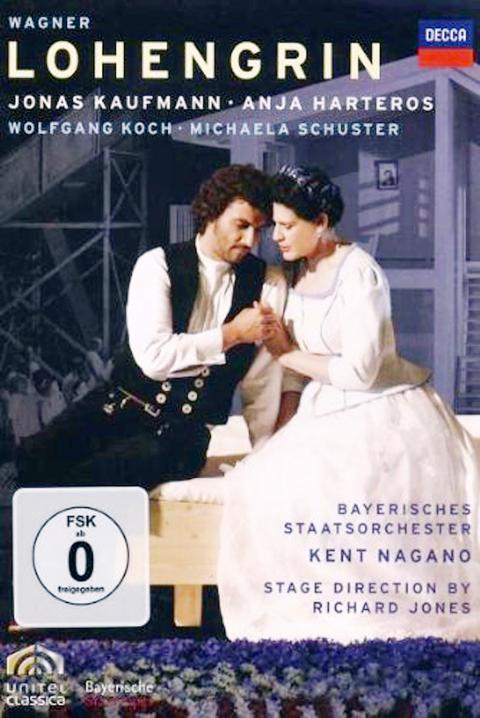A new pair of DVDs of Wagner’s Lohengrin from Decca is of great interest. They bear comparison both with the version starring Placido Domingo and Cheryl Studer and with that starring Peter Hofmann and Eva Marton (plus a stunning Leonie Rysanek as Ortrud). But whereas those two earlier renditions were traditional in staging, this one is different, and needs some explanation.
The opera, meant to take place in medieval northern Europe, is here set in the 1930s, though Lohengrin’s blue T-shirt, not to mention a video camera at one point, look out of place even for that. A fascist state is suggested, with guards holding back the populace (loyal enough, you would have thought) and be-suited thugs protecting the villainous Telramund. More significant is the construction throughout most of the opera of an onstage house. This is Lohengrin and Elsa’s future love nest, and you know in advance that it will eventually be brought to ruin, though how this happens comes as a surprise.
This kind of treatment could ruin an intensely Romantic opera like Lohengrin, but it’s carried off with professionalism and just manages to work. Most important is that the musical values of the production are so high that it would have taken more than even this to throw it off track.

The Lohengrin of the young Jonas Kaufmann made the headlines, and he is indeed outstanding throughout. But the Elsa of Anja Harteros proves to be every bit his equal, while the Telramund of Wolfgang Koch is so dynamic he threatens to outshine even the two leads. Michaela Schuster as Ortrud is also of stellar quality, as are Christof Fischesser as Heinrich and Evgeny Nikitrin as the Herald. This, in other words, is a Lohengrin without a weak link, and the Bayerisches Staatsorchester and chorus, with Kent Nagano conducting, are also outstanding.
So if you want a modern version of this opera, with the highest musical qualities, this version from the Munich Opera House can be unreservedly recommended. If part of the attraction of Lohengrin for you is what Thomas Mann praised as its unique evocation of the medieval dream, an idealized yet vividly concrete world of mystic faith and heraldic shields, then you will be wise to stay with one of the earlier versions.
The camera work of this Lohengrin is exceptionally clear and strong. Kaufmann in tears at having finally to reveal his name and origin, Harteros neurotically pacing back and forth, Nikitin issuing the leader’s orders through a 1930s microphone — all are caught in close-up and with great precision. The video director is Karina Fabich.

The controversial staging is by Richard Jones, the enfant terrible of British theater and opera whose production of Wagner’s Ring cycle at Covent Garden in the mid-1990s was greeted, on its opening night, with howls of derision. He seems to have more nearly got it right this time, though purists will continue to disapprove.
As for Kaufmann, he was invited to sing Lohengrin at Bayreuth shortly after this Munich debut, and will sing Siegmund at the Met next month in the second installment of Robert LePage’s Ring cycle.
La Danse is a long film (150 minutes) about the ballet division at the Paris Opera. It’s the work of the famous US documentary filmmaker Fred Wiseman, known for his many depictions of American institutions. Here he brings his skills to Europe. Where the participants speak French there are English subtitles.

Wiseman’s method here is to do without commentary. Thus you begin by watching a workout in a studio, with the same routines being repeated again and again. Then, after brief panoramic views of Paris and the traffic down in the streets, it’s back to the rehearsal studio. There’s a polite exchange between a dancer and member of the administration, then you see a beekeeper on the roof of the opera house tending to his hive. At another point you see a cleaner vacuuming the red carpets between the seats, all without explanation.
The result is material for an analysis. Here it all is, Wiseman is saying. Make what you like of it. Most balletomanes will relish it, and see it as containing the truth about the hard lives of professional dancers.
Others will find it over-long and unfocused. There may be some humor in the juxtapositions, but if so it’s pretty muted.
On 1 May every year the Berlin Philharmonic Orchestra gives a concert in some European cultural site to celebrate its founding. In 2010, it was Oxford’s Sheldonian Theater. Daylight streams in through Christopher Wren’s many windows as Daniel Barenboim steps up to the podium for a notable concert.
The two main items are Elgar’s Cello Concerto, with the young US cellist Alisa Weilerstein, and Brahms’ First Symphony.
There’s a problem with DVDs of orchestral concerts. What is being gained by the visual dimension? A sense of occasion, certainly, and it’s useful for novices to see the instruments being played. This DVD has these advantages, and in the concerto Weilerstein conveys a strong sense of heartfelt dedication. If, apart from that, this seems just another concert, well, it is the Berlin Philharmonic, and you can’t get much better than that.

On April 26, The Lancet published a letter from two doctors at Taichung-based China Medical University Hospital (CMUH) warning that “Taiwan’s Health Care System is on the Brink of Collapse.” The authors said that “Years of policy inaction and mismanagement of resources have led to the National Health Insurance system operating under unsustainable conditions.” The pushback was immediate. Errors in the paper were quickly identified and publicized, to discredit the authors (the hospital apologized). CNA reported that CMUH said the letter described Taiwan in 2021 as having 62 nurses per 10,000 people, when the correct number was 78 nurses per 10,000

As we live longer, our risk of cognitive impairment is increasing. How can we delay the onset of symptoms? Do we have to give up every indulgence or can small changes make a difference? We asked neurologists for tips on how to keep our brains healthy for life. TAKE CARE OF YOUR HEALTH “All of the sensible things that apply to bodily health apply to brain health,” says Suzanne O’Sullivan, a consultant in neurology at the National Hospital for Neurology and Neurosurgery in London, and the author of The Age of Diagnosis. “When you’re 20, you can get away with absolute

When the South Vietnamese capital of Saigon fell to the North Vietnamese forces 50 years ago this week, it prompted a mass exodus of some 2 million people — hundreds of thousands fleeing perilously on small boats across open water to escape the communist regime. Many ultimately settled in Southern California’s Orange County in an area now known as “Little Saigon,” not far from Marine Corps Base Camp Pendleton, where the first refugees were airlifted upon reaching the US. The diaspora now also has significant populations in Virginia, Texas and Washington state, as well as in countries including France and Australia.

May 5 to May 11 What started out as friction between Taiwanese students at Taichung First High School and a Japanese head cook escalated dramatically over the first two weeks of May 1927. It began on April 30 when the cook’s wife knew that lotus starch used in that night’s dinner had rat feces in it, but failed to inform staff until the meal was already prepared. The students believed that her silence was intentional, and filed a complaint. The school’s Japanese administrators sided with the cook’s family, dismissing the students as troublemakers and clamping down on their freedoms — with